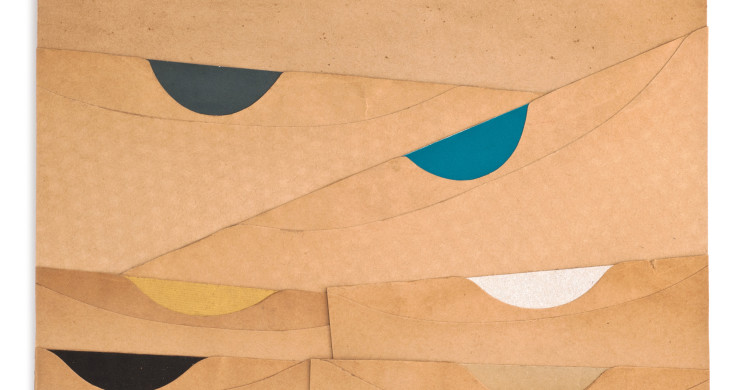The duty of policing the borders of what art is and who is an artist can be an uninteresting and hazardously mind-numbing task. But this year, when we witnessed the Venice Biennale’s Palazzo Enciclopedico (The Encyclopedic Palace) labeled the outsider or visionary Biennale, one does begin, despite herself, to ponder, “what does mark an image or object as Art, anyway?”
The short answer, which we have lived with for 100 years is the self and a community. That is, individual determination and communal validation. Often the latter helps along the former, and vice versa. One’s desire to make followed up by a willingness or drive to share it, collides with a community, be it esoteric, academic, or market driven, who’s affirmation propels forward to art-dom. This narrative can be reversed of course, as we have seen with the quilts of Gee’s Bend.
In the current three-person exhibition at Portland, Oregon’s Adams and Ollman both roads, self determination and institutional validation, have been traveled. On display are works from Acharya Vyakul, Chris Johanson, and Chris Corales. Three artists who’s work, in production and/or content, involve the meditative.
For the Indian painter Acharya Vyakul (1930-2000) the meditation or inspiration to create was a wholly spiritual endeavor. In the tradition of Tantric paintings, Vyakul’s works were all created in the throes of divine ecstasy. The four small pieces here, the largest still under 12 inches, range from a central focus pointed concentric triangle in red, oddly cropped at the top of the page, to receding tubular forms in two-tone lavender, as well as abstracted calligraphy. The page is barely able to contain these forms. The works are all dated circa 1990, the year after Vyakul was first exhibited in the controversial Magiciens de la Terre at the Centre Pompidou, curated by Jean-Hubert Martin, on the heals of 1989 NY MOMA show, Primitivism. This was an exhibit Martin wished to distance himself from as he saw it as more of the same old Western colonialism. While looking at Vyakul’s paintings one can’t help but think of his state of mind at the times of their creation. The immediacy of the line, coupled with the quirky compositions, run counter to the delicacy of the palette, resulting in a vibration upon the viewer’s sensibility.
Immediacy is a hallmark in the paintings and installations of Chris Johanson. Since the mid 1990’s, through his sprawling installation, which extended into in the stairwell in the 2002 Whitney Biennial, to his more recent sallies into abstraction, as well as his musical output with bands such as Sun Foot, he has constantly given us an honest reflection of society. His work, as Jon Raymond wrote so succinctly, “is both corrosive and deeply sympathetic, burning with irony but never outright judgment.” On view are examples of his wit, floating from the mind of simply painted men who’s sage quips burst out of cartoon speech bubbles. His tone ranges from the potent, That bump in the road was sure a bump in the road, 1999-2013, to chilling, as in the painting Selfish expressionism #1, 1994-2013. Here a nude man in a non-Euclidean spaces wonders, “Is today a good day to shave off some of my medication?” Also included are two of his abstractions. One What is or can be, 2013 is done in Johanson’s version of a refined style, brightly colored and skewed geometry. The other Everywhere you look, 1994-2013, blends more of his cartoony style and pastel passion with a spatial delineation made of wispy marks, evoking the 1911 compositions of Wassily Kandinsky.
The delicate abstract collages of Chris Corales also conjure the work of the early 20th century avant-guarde. Corales is a collector of fine and prosaic vintage paper which he utilizes in skinny slivers and square chunks as in formal explorations of compositional space. Here worn and faded record sleeves for 78’s are cut short, and accented with half circular tabs of reds, blues, and whites. The arrangements are landscapish forms and repeat in a series titled, Dune Kiosk (1-4) 2013. The paper exudes a material history: time has left their color and finish bleached, and some contain faint sun-spotted patterns. The colors on the tabs are rich and flat, though differing high fiber content provides lovely texture for the careful viewer. Corales is currently living in Philadelphia, but hails form the same punk DIY Bay Area scene as Johanson. While one would shy away from placing Corales in the late 1990’s Mission School, there are correspondences in his reuse practice, passion for color, and intense work ethic. Not to mention the shared community and camaraderie, which spurred them both past the Art border guards and towards lasting careers.
This exhibition provides a platform for aesthetic pleasure and philosophical thought regarding the path that images, objects, and people have to traverse in order to attain the title of Art and Artists.
Mack McFarland is an artist and curator at the Pacific Northwest College of Art’s Philip Feldman Gallery + Project Space.
























